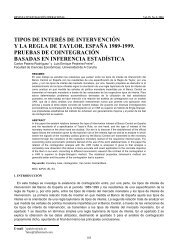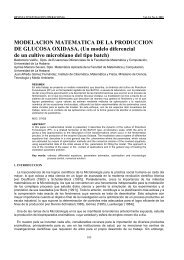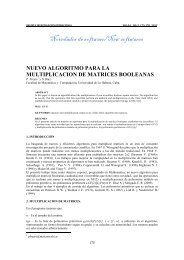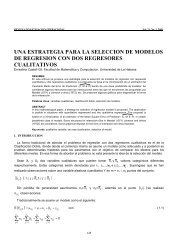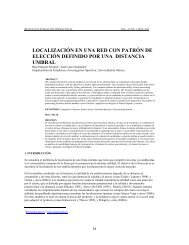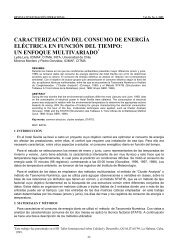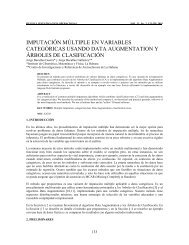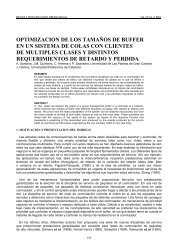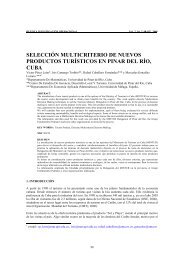numero de condicion y determinante de una matriz - revista ...
numero de condicion y determinante de una matriz - revista ...
numero de condicion y determinante de una matriz - revista ...
You also want an ePaper? Increase the reach of your titles
YUMPU automatically turns print PDFs into web optimized ePapers that Google loves.
ρ(A) ≈ 10 21 (16)<br />
Por otra parte, con respecto a A -1 , sustituyendo en (11):<br />
<strong>de</strong>t( A<br />
−1<br />
⎡ 10<br />
− λI)<br />
= <strong>de</strong>t ⎢<br />
⎣ −10<br />
−7<br />
−14<br />
− λ<br />
−10<br />
10<br />
−28<br />
−21<br />
⎤ 2<br />
⎥ = λ − ( 10<br />
− λ⎦<br />
−7<br />
+ 10<br />
El mayor |λi| es aproximadamente igual a 10 -7 , por lo que<br />
−21<br />
) λ + 10<br />
ρ(A -1 ) ≈ 10 -7 (17)<br />
Sustituyendo (16) y (17) en (15) se obtiene que<br />
cond(A) ≥ 10 21 ⋅ 10 -7 = 10 14 ,<br />
in<strong>de</strong>pendientemente <strong>de</strong> la norma matricial utilizada.<br />
Conclusión 1: Para cualquier norma la <strong>matriz</strong> <strong>de</strong>l ejemplo tiene un número <strong>de</strong> condición gran<strong>de</strong>, inclusive si<br />
trabajamos con doble precisión, a pesar <strong>de</strong> que el <strong>de</strong>terminante es gran<strong>de</strong>.<br />
Pasemos ahora a respon<strong>de</strong>r la pregunta 2:<br />
2) <strong>de</strong>t(A) pue<strong>de</strong> ser pequeño y cond(A) no ser gran<strong>de</strong>.<br />
A =<br />
En este caso trabajaremos con <strong>una</strong> aritmérica flotante <strong>de</strong> 14 dígitos <strong>de</strong>cimales (doble precisión), y la <strong>matriz</strong><br />
⎡ −<br />
10<br />
⎢ −<br />
⎢ 10<br />
⎢<br />
⎣<br />
2 ⋅10<br />
7<br />
7<br />
−7<br />
10<br />
−7<br />
2 ⋅10<br />
10<br />
−7<br />
−7<br />
1⎤<br />
⎥<br />
1⎥<br />
1⎥<br />
⎦<br />
<strong>de</strong>t(A) =<strong>de</strong>tnorm(A) ≈ - 10 -14 , (18)<br />
cuyo módulo es un número pequeño, tanto <strong>de</strong>s<strong>de</strong> el punto <strong>de</strong> vista absoluto como relativo a los datos, ya<br />
que es 10 7 veces inferior al menor <strong>de</strong> los coeficientes. Inclusive en nuestro ejemplo <strong>de</strong>t(A) es el or<strong>de</strong>n <strong>de</strong> la<br />
unidad <strong>de</strong> redon<strong>de</strong>o u <strong>de</strong> la aritmética flotante. De (10):<br />
||A|| ∞ = 1.0000003 (19)<br />
Por otra parte<br />
33<br />
−28<br />
−10<br />
−42<br />
= 0



